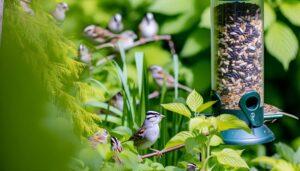How to Properly Identify the Black-chinned Sparrow: Scientific Name and Features
The Black-chinned Sparrow, scientifically named Spizella atrogularis, belongs to the family Passerellidae. It is distinguished by its black throat patch, sleek gray body, and pinkish-brown wings.
These sparrows inhabit arid scrublands and chaparral regions in the southwestern United States and parts of Mexico, thriving at elevations up to 2,500 meters. They primarily forage on the ground, feeding on seeds, insects, and arachnids, and adapt their diet seasonally.
Conservation efforts focus on habitat protection and addressing threats from land development and climate change. Understanding these aspects reveals much about their ecological role and survival strategies.

Key Takeaways
- The Black-chinned Sparrow belongs to the family Passerellidae.
- Its genus is Spizella.
- The species epithet for the Black-chinned Sparrow is atrogularis.
- The scientific name of the Black-chinned Sparrow is Spizella atrogularis.
- It is genetically related to other Spizella species.
Scientific Classification

The Black-chinned Sparrow's scientific classification places it within the family Passerellidae, which includes a diverse array of small, seed-eating birds known for their distinct vocalizations and plumage patterns.
This sparrow's genus, Spizella, comprises several North American species that thrive in various habitats. Its specific epithet, atrogularis, derives from Latin, meaning 'black-throated,' accurately describing one of its defining features.
The classification underscores the evolutionary relationships and ecological niches these birds occupy. Research indicates the Black-chinned Sparrow's close genetic ties to other Spizella species, illuminating adaptive traits that allow it to flourish in arid and semi-arid environments.
This bird's place within Passerellidae highlights its role in the broader tapestry of avian biodiversity and ecological balance.
Physical Characteristics
Sporting a distinctive black throat patch, the Black-chinned Sparrow exhibits a sleek gray body complemented by subtle pinkish-brown wings and a conical bill adapted for seed consumption. The adult male often showcases a darker head, enhancing its striking appearance, while the female displays more subdued tones. Their tail, relatively long and narrow, aids in agile flight through dense shrubbery. The following table breaks down key physical attributes:
| Feature | Description |
|---|---|
| Throat Patch | Black, prominent |
| Body Color | Gray, sleek |
| Wing Color | Pinkish-brown, subtle |
| Bill Shape | Conical, ideal for seeds |
| Tail | Long, narrow |
| Sexual Dimorphism | Males darker, females subdued |
Observing these characteristics reveals the species' adaptations that secure survival and reproductive success in their natural habitats.
Habitat and Range

Inhabiting arid scrublands and chaparral regions, the Black-chinned Sparrow shows a strong preference for environments characterized by dense, low-lying vegetation and rocky outcrops. This habitat selection is essential for both nesting and foraging.
Research indicates that these sparrows are mainly found in the southwestern United States and parts of Mexico. They thrive in elevations ranging from sea level up to 2,500 meters.
Seasonal variations influence their range; they migrate to lower elevations or more temperate areas during winter. Their presence in these habitats underscores their adaptability to harsh, dry conditions, which often deter other avian species.
Understanding their habitat preferences emphasizes the significance of these unique ecosystems for their survival and reproduction.
Behavior and Diet
Given their adaptability to arid environments, Black-chinned Sparrows exhibit fascinating behaviors and a diet intricately linked to their habitat. These small birds are primarily ground foragers, meticulously searching for seeds, insects, and arachnids. During breeding season, males ascend shrubs to deliver melodious songs, marking their territory and attracting mates. Their diet shifts seasonally, balancing nutritional needs and resource availability.
| Season | Primary Diet |
|---|---|
| Spring | Insects, Spiders |
| Summer | Seeds, Insects |
| Fall | Seeds, Grains |
| Winter | Seeds, Sparse Insects |
Research shows their diet's diversity supports their resilience in fluctuating environments. Observing their feeding and nesting behaviors provides valuable insights into their survival strategies in harsh, arid landscapes.
Conservation Efforts

Efforts to preserve the Black-chinned Sparrow focus on habitat protection, addressing factors such as land development, climate change, and invasive species that threaten their arid ecosystems.
Conservationists prioritize maintaining native shrublands, essential for nesting and foraging. They implement controlled burns and mechanical thinning to manage overgrown vegetation, restoring the natural habitat balance.
Research highlights the species' sensitivity to climate fluctuations, prompting initiatives to monitor and mitigate climate impacts. Efforts also target invasive plant species, which outcompete native flora essential for the sparrow's survival.
Collaboration with governmental and non-governmental organizations ensures the promotion of sustainable land-use practices. Public awareness campaigns emphasize the importance of conserving arid habitats, fostering a community-driven approach to preserve this sparrow's ecological niche.
Conclusion
Ironically, while the Black-chinned Sparrow (Spizella atrogularis) thrives in arid scrublands, its survival hinges on meticulous conservation efforts.
It's amusing how this seemingly unremarkable bird, with its modest plumage and elusive nature, commands such scientific attention. Observing its habitat preferences, dietary habits, and breeding behaviors reveals a complex avian species.
Yet, despite its resilience in harsh conditions, human-induced habitat loss could tip the scales. Therefore, preserving this sparrow's understated existence demands our utmost commitment.






